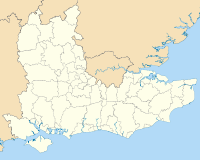East Hampshire
East Hampshire
East Hampshire District | |
|---|---|
 East Hampshire shown within Hampshire | |
| Sovereign state | United Kingdom |
| Constituent country | England |
| Region | South East England |
| Non-metropolitan county | Hampshire |
| Status | Non-metropolitan district |
| Admin HQ | Petersfield |
| Incorporated | 1 April 1974 |
| Government | |
| • Type | Non-metropolitan district council |
| • Body | East Hampshire District Council |
| • Leadership | Leader & Cabinet (No overall control) |
| • MPs | Damian Hinds George Hollingbery |
| Area | |
• Total | 198.6 sq mi (514.4 km2) |
| • Rank | 76th (of 296) |
| Population (2022) | |
• Total | 127,319 |
| • Rank | 185th (of 296) |
| • Density | 640/sq mi (250/km2) |
| • Ethnicity | 98.3% White |
| Time zone | UTC0 (GMT) |
| • Summer (DST) | UTC+1 (BST) |
| ONS code | 24UC (ONS) E07000085 (GSS) |
| OS grid reference | SU7659323528 |
| Website | www |
East Hampshire is a local government district in Hampshire, England. Its council is based in Petersfield. Other towns are Alton and Bordon.
The district was originally to be known as the District Council of Petersfield. It comprised 42 seats and first met on 18 June 1973. For ten months it operated alongside the councils that it was formed to replace: the Alton and Petersfield urban districts along with Alton Rural District and Petersfield Rural District.
On 8 October 1973, the new council changed its name to the current East Hampshire District Council (or EHDC as it is usually known).
On 1 April 1974, the old councils were dissolved, leaving only EHDC.
Sandy Hopkins was the first joint Chief Executive in Hampshire when she was appointed to head both EHDC and Havant Borough Council in October 2009.
Councillors approved the business case put forward by the Chief Executive for a shared management team between the two authorities in June 2010.
The new team took up its position in October 2010 and consists of five Executive Heads reporting to two Executive Directors. This is a reduction in senior management from 15 to 7 positions.
Politics
East Hampshire District Council is elected every four years, with currently 44 councillors being elected at each election. The Conservative party has controlled the council for much of its history including having a majority from 1976 to 1991, with the only other party to have had a majority being the Liberal Democrats from 1991 to 1999. Most recently the Conservatives have controlled the council since the 1999 election, and as of the 2011 election the council is composed of the following councillors:-[1]
| Party | Councillors | |
| Template:British politics/party colours/Conservative| | Conservative Party | 39 |
| Template:British politics/party colours/Liberal Democrat| | Liberal Democrats | 5 |
Settlements and parishes
For a list of civil parishes in East Hampshire, see List of civil parishes in Hampshire#East Hampshire.
Settlements in East Hampshire include:
- Alton
- Beech, Bentley, Bentworth, Binsted, Blackmoor, Blendworth, Bordon, Bramshott, Bucks Horn Oak, Buriton
- Catherington, Chawton, Clanfield, Colemore
- East Meon, East Tisted, East Worldham, Empshott
- Farringdon, Finchdean, Four Marks, Froxfield
- Golden Pot, Grayshott, Greatham
- Hawkley, Headley, Headley Down, High Cross, Holybourne, Horndean
- Kingsley
- Langrish, Lasham, Lindford, Liphook, Liss, Lower Froyle, Lower Wield
- Medstead
- Neatham, Newton Valence, North Street
- Petersfield, Priors Dean
- Ropley, Ropley Dean, Rowlands Castle
- Selborne, Shalden, Sheet, Steep, Stroud
- Upper Froyle, Upper Wield
- West Tisted, West Worldham, Weston, Whitehill
References
- ^ "England council elections". BBC News Online. Retrieved 3 September 2011.


